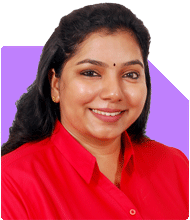52 Year Old Unmarried Seeking Yoga, Career, Finance Advice After Break
Pushpa R | Answer |Ask -Follow
Yoga, Mindfulness Expert - Answered on Nov 06, 2024
In the last 10 years, she has trained over 400 people in yoga and counselled many others at corporate events.
She holds a master of science degree in yoga for human excellence from Bharathidasan University, Trichy.
Pushpa specialises in meditation, yoga for wellness and mindfulness.... more

Hi Pushpa, I am 52 Year old never married single. During childhood I had a practice of yogasanas through RSS. But now had a big break. How can I start it again? I have knee pain. Also advise me for financial success and career success as I have under performing career irrespective my 4 Post Graduations qualifications. Thank you. Regards Hanumanth
Gentle Yoga for Joint Support: Begin with poses like Sukhasana (Easy Pose) for meditation and Bhujangasana (Cobra Pose) to strengthen the back without straining the knees. Chair yoga may also be useful to protect your joints.
Law of Attraction Meditation: Daily visualization meditation can be powerful for career and financial goals. Imagine yourself achieving success, feeling confident and fulfilled. When done consistently, this “law of attraction” meditation builds a positive mindset and aligns your thoughts with your goals.
Pranayama (Breathing Exercises): Practicing Anulom Vilom (Alternate Nostril Breathing) increases focus and clarity, which supports mental well-being and career decision-making.
Partnering with a coach will help you practice safely and effectively, ensuring every step aligns with your body’s needs. With proper guidance, yoga and meditation can inspire growth in every area of life.
R. Pushpa, M.Sc (Yoga)
Online Yoga & Meditation Coach
Radiant YogaVibes
https://www.instagram.com/pushpa_radiantyogavibes/
You may like to see similar questions and answers below
Roopashree Sharma | Answer |Ask -Follow
Yoga, Naturopathy Expert - Answered on Jun 21, 2023
Sabrina Merchant | Answer |Ask -Follow
Yoga Expert - Answered on Jul 21, 2024
Ramalingam Kalirajan |10906 Answers |Ask -Follow
Mutual Funds, Financial Planning Expert - Answered on Dec 19, 2025
Nayagam P P |10859 Answers |Ask -Follow
Career Counsellor - Answered on Dec 19, 2025
Ramalingam Kalirajan |10906 Answers |Ask -Follow
Mutual Funds, Financial Planning Expert - Answered on Dec 19, 2025
Ramalingam Kalirajan |10906 Answers |Ask -Follow
Mutual Funds, Financial Planning Expert - Answered on Dec 19, 2025
Ramalingam Kalirajan |10906 Answers |Ask -Follow
Mutual Funds, Financial Planning Expert - Answered on Dec 19, 2025
Radheshyam Zanwar |6751 Answers |Ask -Follow
MHT-CET, IIT-JEE, NEET-UG Expert - Answered on Dec 19, 2025
Radheshyam Zanwar |6751 Answers |Ask -Follow
MHT-CET, IIT-JEE, NEET-UG Expert - Answered on Dec 19, 2025
Samraat Jadhav |2514 Answers |Ask -Follow
Stock Market Expert - Answered on Dec 18, 2025
Reetika Sharma |432 Answers |Ask -Follow
Financial Planner, MF and Insurance Expert - Answered on Dec 18, 2025
Reetika Sharma |432 Answers |Ask -Follow
Financial Planner, MF and Insurance Expert - Answered on Dec 18, 2025


























